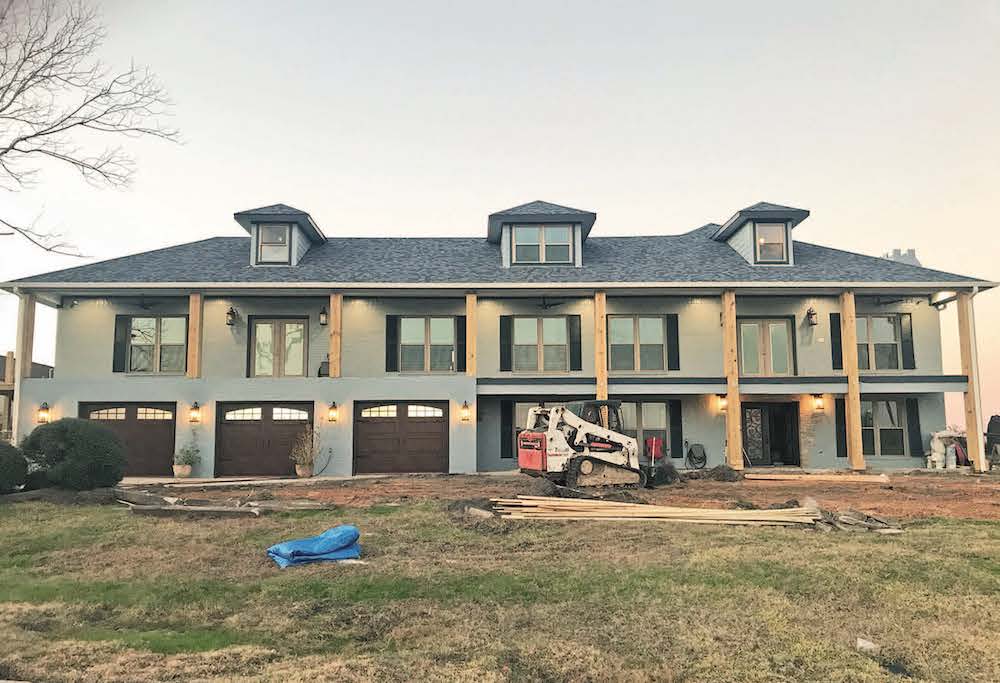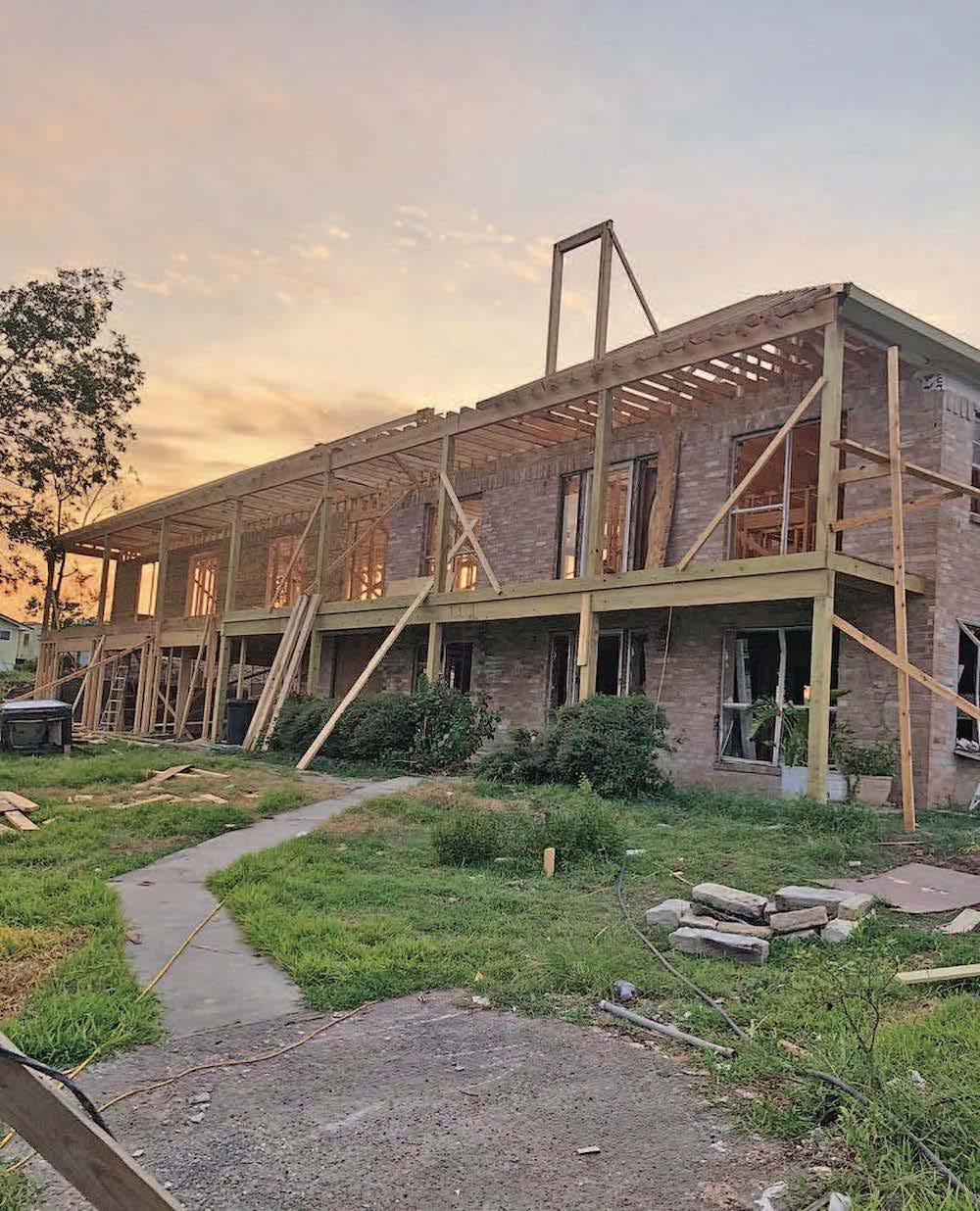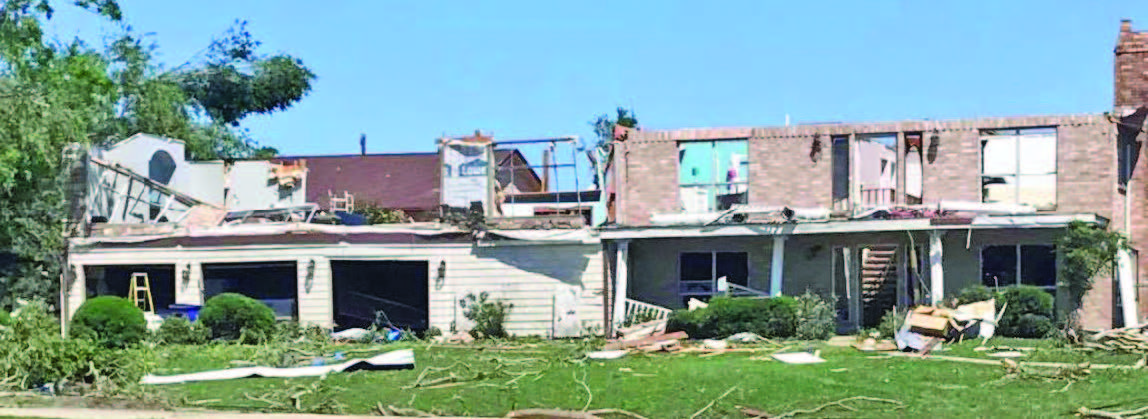
By Debbie Robins Jeremiah 29:11. For I know the plans I have for you declares the Lord; plans to prosper you and not to harm you, plans to give you hope and a future.
Because of Him, we are stronger than ever. Stronger than ever? That was the last sentence I typed when I originally wrote the article about the April 22, 2020 tornado that destroyed our home of 20 years. For I know the plans I have for you declares the Lord, plans to prosper and not harm? How could that be true after a devastating storm touched down and took 3 lives? Took homes away from families. Their belongings strewn into a careless wind tunnel, with no discrimination of age. No care for the people that would become homeless. No mercy for those who were already having their own struggles just trying to get through life.
The struggles have been real. It has been more than 5 months since the tornado touched down. In short, the house is in the process of being re-built. We have been very blessed to have several amazing builders and contractors build this Ark. If we learned anything from this ordeal, it is to truly love your neighbors as yourself, and to trust in the Lord. This is where we obtained our strength. And this is where it all began….
Living in a hotel for 2 months while trying to decide if we should rebuild or move on, was a difficult decision, to put it mildly. We spent most of our days collecting receipts, itemizing items for insurance, and doing laundry. I learned that if I bought totes, it was easier to organize our belongings while in the hotel. I had totes of food, toiletries, shoes, tools, insurance receipts, blankets, pillows. Everything we could salvage that we may need at the hotel. Except Kip didn’t have socks. So, he went and bought socks. Who would think something so little, such as owning a pair of socks would be important enough to write about? The little things really did matter. Friends and coworkers gave us totes of snacks for the kids, and we received gift cards to restaurants and Lowes. It was amazing and so very helpful. Hotel living with a family of 5, plus 2 dogs, and no real space to spread out, was starting to get to all of us. We had stopped living. All that we knew at that moment was stress and an unknown future. Kip surprised me one night and took me to a dinner in Galveston; hoping to bring back some of the happy times we have always known together. We ordered dinner from the waiter, and there we were, just sitting at dinner like we used to do. I looked up at him, watching as he stirred his tea. I remember we always loved to make tea at home. I started thinking about that word: Home. We didn’t have one anymore. Tears started swelling up in my eyes, and I looked away quickly, hoping he wouldn’t notice. I tried to ignore the huge lump in my throat as I struggled to fight back the tears, that appeared from nowhere. I couldn’t stop them. Tears rolled down my cheeks, and he saw. He grabbed both of my hands from across the table and held them firmly. He asked, “What’s wrong?” I sobbed, “I just want to go HOME!” The next thing I knew, we were holding hands across from each other with our arms on the table, and we both had tears running down our faces. At that very moment, our Pastor, Brother Randy Piatt called. We hadn’t spoken to Randy in months, but we had been messaging each other through all of this. How in the world did he know to call right this moment? Kip answered, and they prayed together, and after they hung up, Kip shared the conversation with me. We both felt a lot better, as this was just the little nudge of encouragement we needed at that very moment. This enabled us to look at the bright side of things, and we would see the sunshine through the clouds.

Our day got a little brighter a few weeks later, when our daughter Jordan and our amazing son-in law (who we call our son), flew in from Honolulu, Hawaii to surprise us after the tornado destroyed the family home. Jordan is a sergeant in the Army, and Grant already served his Army time, after re-enlisting. During Covid-19, the military was extremely strict on allowing travel for their enlisted, so we knew Jordan and Grant wouldn’t be able to fly down after the tornado. But somehow, they got special permission, and showed up on the front lawn. I was inside cleaning up debris, while talking on the phone. I looked outside to see two people walking up. This was common, as people were always walking up to say, "Hi," or to pass out food or toiletries to tornado victims. I didn’t even recognize them, nor would I have ever fathomed they would be able to fly to Texas. It was them. Jordan and Grant were walking across our front yard. I kept looking at them, thinking surely I’m mistaken. I dropped my phone call and gave them a big hug. This was the happiest we had been in a while. To have our kids home during this tragedy was such a needed blessing. Our other kids couldn’t come down, and it would be far too emotional for them, not to mention they had work and weren’t able to leave. But we were extremely blessed to have Jordan and Grant home. We all stayed back at the hotel the week they were here, enjoying each other’s company. We made many trips to the house, and they helped us pack up and dishes and food that was salvageable in the cabinets. It was hard when it was time for them to leave, but I was happy for the time we got with them.
After the kids left to go back home, we made trips to the house almost daily, to haul off storm debris, knock out walls, haul huge, heavy piles of wood, glass, and sheetrock to the curb, hoping the city would pick it up as promised. Many hours of difficult, manual labor were put into this, and working in 100 degree temperatures was extremely difficult and exhausting. We faced many challenges.
It seemed that every time we went to the house, it was raining. Not just a sprinkle, but rain. It was almost like something was telling us to go away. Don’t rebuild here. It’s not worth it. The house is a complete wreck. It’s a wet, demolished, soggy mess. You could smell the rotting sheetrock, and the mold growing on the wood. Flies were out of control, chasing us around, dodging a swat. We bought a “fly salt gun” just to have some fun shooting at the flies. It looked like a toy rifle, but you load it with salt, aim it at the flies, and pow. It was oddly satisfying.
We tried buying bug spray and fly bait at stores, but they were all sold out. Every time we went inside the house, it seemed to get worse and worse with the smells of the soaked wood, house debris, wet sheetrock, and the flies. As it rained, water poured from our ceiling above us, and soaked our heads and clothes. There were puddles of dirty water on the tile. When we went upstairs, all that existed was a staircase to nowhere. There were a few leaning walls, that were somehow still standing, and the sky. That’s it. (We always liked the open concept look, but this wasn’t exactly what we had in mind.) It was very disheartening to stand upstairs with no roof, no ceiling. You just felt vulnerable. We asked ourselves countless times, “What are we doing?” Why are we even pondering the thought of rebuilding this mess. It’s awful. Maybe we are just confused, or stressed out, and don’t know where else to go or what to do. God, we need a sign. Please, just give us a sign so that we know what you want us to do. Silence. The only sign we received was more rain. Soaking wet, exhausted, confused, stressed out, and basically homeless, we decided to head back to the hotel. I loaded Mikie and the wet dogs up in the car, while Kip was still inside rummaging through the house.
I caught a glimpse of him standing upstairs, or what used to be upstairs, in the old “Beach Room.” (I had themed bedrooms). He was just standing there, upstairs, exposed under the open sky, while it rained on him. He was looking helpless and overwhelmed with confusion and doubt. I saw him look around, walk a few steps, stop, and just stare again. I felt awful for him. He’s the man of the house; the one with all the answers or solutions. But this time,
he lacked both. He then disappeared out of sight, as I waited in the car; rain tapping on the roof. I just kept looking at that house thinking, “There’s just no way, this house is a huge mess.” I must have said those words a million times. A few moments later, he got in the car and just sat in silence, drenched. We just sat there without talking for what seemed like an eternity.
Then, out of nowhere, he pulls out a photograph that he was holding. It was a photo of a double rainbow, that we had taken over 10 years ago.
The double rainbow in the photograph was shining brightly across the lake, right in front of our home. It was not often that we would see a double rainbow, so we felt very lucky to have captured it with our camera. This was back in the day where we would develop all our photographs.

The picture was wet and faded. I just looked at him with a confused expression on my face. Typical these days. Kip explained that as he was walking around the house upstairs, he went to the laundry room. He told me he was talking to God, asking what to do with the house. He said he looked down at the floor, and he spotted something poking out from underneath the washing machine. He reached down to pick it up, and discovered it was the picture of the double rainbow. When he first showed me the photo, I was not sure why this photo was so significant to Kip. He then flipped it over and I noticed there was writing on the back
of it. We had never seen that anyone had written on the back of" "this photograph before this day. There was no doubt, this was Victoria’s handwriting. The writing was more than just words written on the back of a photograph, scribbled by a 10-year-old child; these words would mean something significant to our entire family all these years later. Victoria, our 24-year-old daughter, had written on the back of this photo when she was about 10 years old. In cursive writing, it said, “A Piece of Home.” Oh my gosh. That was our sign. This is the sign from God we had been waiting for. An answer to our prayers. This rainbow signifies God’s Promise. Here we were, sitting in the car holding
a wet photo, looking at a demolished house that was getting more soaked by the rain, and we just received our answer. God’s Promise. While sitting in the car in the driveway that rainy day,
Kip and I looked at each other as tears swelled up in our eyes. We really didn’t have much to say. We sat in silence in the car, rain still coming down. We both knew what this meant. We took one last look at our house that was in shambles as we backed out of the driveway. We stopped one last time, looked at the house, and he exclaimed, “You see Debbie, this is God’s Promise. We are coming home, and we will rebuild.”
We left that afternoon feeling content, feeling this was the right decision.
After that day, we had more ambition, more confidence, more strength. We were stronger than ever. Kip worked for many days drawing out his own blueprints for the house. He isn’t an architect, or a builder. But he drew it exactly as we wanted it, and today, it is built exactly as it was drawn by him. I’m not sure how he was able to draw out a blueprint, demolish his home, rebuild his home, and work a full-time job. It was catching up to him though. The stress became too much, as the demands of his job and the builders were colliding in a force too strong for him to conquer. He decided to leave his job, as he had a home to build. So, I started calling him “Noah,” after Noah’s Ark. God had given him the ability and knowledge to draw up floor plans and manage a rebuild. It has gone rather smoothly, considering the size of this new “Ark,” and the amount of damage done from the tornado. Our daughter Victoria who wrote those words on the rainbow photograph, is also an artist, who lives in California with her amazing husband, (who we also call our son). She painted us a large painting of an Octopus for one of our themed rooms in the house, a few years ago. This painting was lovingly named, “Paths,” for all the paths that we take along the way in life. We treasured this painting, as it was from Victoria, and meant so many different things to everyone. We had Paths hanging in the media room, which was blown away by the tornado. Paths was found later, but he was mangled, wet, and damaged beyond repair. Since we lost that beloved painting, we asked Victoria to paint us another Paths. She obliged but she decided the new painting would be a little different. We now have “Octavia.” Octavia means strength, and eight. We are not sure what the “eight” will mean for us, but the word “strength” has a lot more meaning to us these days. Octavia is a beautiful Octopus painting in brighter colors, and her canvas is larger than Path’s canvas was. We are eagerly awaiting to adorn our walls with Octavia in our new home.
The word “home” sounds very exciting to us, but this build would not be possible without the amazing workmanship of a dear friend, Jerry Foote. He was there for us several years ago when we were remodeling the house. He hung new sheetrock, paint, and all of the trim work inside. After the tornado, he called to check on us, and asked if there were anything he could do to help us. He is an expert at his job. He is now working on our house as if it were his own. He is very respectful, knowledgeable, and highly skilled. He has been there since the beginning, designing, and installing all the plumbing, he has built a retaining wall, hung doors, cut out concrete; the list goes on, and continues. He has been there every day as a consultant for us, as well as for the other contractors we have on site. He is working hard alongside them and making sure all goes perfectly. We honestly feel we could not rebuild this house without him. We look up to Jerry and will forever be grateful to him for helping to get our home back. He has sacrificed his days to work out in the dangerously hot Texas heat, in the middle of August. Walls have gone up, roof is now on, plumbing and electrical has been installed. Kip installed all of the electrical, as he loves electrical work. We started our search for a framer, to get the house framed in, but we ended up finding a builder and a friend: JC, with JC Construction. With his knowledge and contacts, we have been able to do a lot more than just frame the house. His expertise has given us a stronger home than we could have ever hoped for. His crew constructed our home from a single graph paper that was drawn and re-designed by Kip multiple times. But because of our newfound relationship, the house turned out better than if we had given him and his crew an engineered blueprint. There were many questions that came up during construction, and JC offered suggestions and guidance; never steering us in the wrong way. Without Kip, Jerry, and JC working together, it would not be possible to have our “Ark” as it stands today. We now have a roof, and I’m so grateful. We still have a long way to go.

This brings me to the HVAC system. The week after the tornado hit, and everyone was still scrambling for hope and sanity, Kip happened upon Roger, and didn’t even realize who it was until they started talking. Roger was at the front of our subdivision, with his wife Tammy. They were both grilling hamburgers and hotdogs on their barbeque pits, to feed all of the tornado victims. Roger and Tammy were the couple who came to rescue injured victims by their boat. They are the couple that were out boating the day the tornado hit and came by our peninsula to see if we needed any help immediately after it touched down. Since they were in a boat, they could boat people out to ambulances. They loaded up Taylor, Oma, and the young boy that was injured, and took us all to the Kickapoo Marina to wait on ambulances in the rain, while driving through a debris- filled lake. They let us put doors we used as gurneys on their new boat seats, not caring if we damaged them or their new pontoon boat. Not caring about their own safety, but the safety of those injured. After the tornado, they continued with their heroic actions. They spent countless hours that led into months, cooking hamburgers and other food from their bar-b-que pits and delivering them to the tornado victims. They spent their own money to feed those in need long after the tornado. When Kip first saw Roger grilling the food, he wasn’t sure who he was, until they started talking. Kip realized it was the guy and lady that rescued the victims that were thrown from their homes. Kip asked Roger, “Why did you do what you did that night?” Roger humbly stated, “It was just the right thing to do.” Kip later found out that Roger installed HVAC systems, and he never had any doubt that Roger would be our guy to do the job. When we finally had the house ready to install the system 5 months later, we called on Roger, and he came to the house to do a walk-through. When Roger and I saw each other, we just hugged for a long time, eyes swellingwith tears once again. We didn’t have to say a word; we knew.
Tammy had canned some fresh jars of Cowgirl Candy, several amazing varieties of jellies, and divinity for Roger to give us. I treasured this and didn’t even want to open the jars, as they were such a precious offering. Tammy has her own story of the events of that awful evening, and I hope one day, she shares it. Oma keeps in touch with us. She texts us often and seems happy under the circumstances. She is with her son, as she decided not to rebuild on her property next door to us. She is still recovering but she is having a difficult time physically. In the process of all of this, Oma wanted us to take ownership of her lot. Kip has spent over 20 years taking care of this yard, even before she lived there. But now to purchase it, knowing there won’t be another Oma next door, is very bittersweet. So much of “her” is still on that lot. I remember her always being on her front porch. Her front porch isn’t there anymore. I remember bringing dinner to her front door. Her door is gone. Her house is gone. It is lonely without her here. I remember all of the pies she would bring us, now we only have the memories to cherish since she lives far away from us now.

Kip and Kalyn have since pursued their own dreams and started a new chapter. Kalyn is attending college, aspiring to become a NICU RN, like I did when I first became a nurse. She is currently living in her college dorm. She comes to visit us on weekends when she is able. Kip has been an avid fisherman since the age of 3. He has been a deck hand in the U. S. Virgin Islands in the past and is currently a deck hand for a charter company in Galveston. He just received his Captain’s license and aims to open his own charter business in the near future. We are proud of their resilience despite the adversities they have endured.
Adversity is a word we know all too well. I learned on Facebook that it was Taylor’s birthday on August 28. That morning, I walked to the end of the peninsula and stood looking at the exact location we had found him on April 22. I relived the moment of seeing him on the wet ground, moaning. I relived the moment where we all stood around him as his own brother, and other men loaded him onto a door that was detached from a home, and carried him onto the boat; using the door as a gurney. I relived being by his side when he took his last breath, with tears rolling down my face as I watched helplessly, with no tools to help him and no ambulance in sight. Our only hope was to perform CPR on him, until Paramedics arrived. I talked to Taylor, as I stood looking over the lake towards what used to be his home, and I told him I was so sorry that I couldn’t save him. I told him I think about him and Brooke every day, and that we will always remember them. I told him I know he’s singing his karaoke up there with Jesus and the Angels, and that from this moment on, I will be happy that he is with Brooke in Heaven, and I will not be sad, but that’s easier said than done.
Thankfully, the young boy, who I later found out is Taylor’s nephew, is finally home from the hospital after recovering from the broken bones and surgeries that he endured after being thrown from his house with his mom, Taylor, and Brooke. I won’t be sad any longer, as I know Taylor and Brooke are home together forever. There is a time and a season for everything. A time to be born and a time to die, a time to tear down and a time to build, a time to weep and a time to laugh, a time to mourn and a time to dance. Ecclesiastes 3.
These times of missing Oma, losing Brooke and Taylor, and remembering him on his birthday, are sad reminders of how quickly lives can change, and how the most important thing at that moment, is talking to the person right in front of you, right then. That moment might not be there again. That moment will soon be a memory. Now is the time to count our blessings, love more, and rebuild our lives. It’s time to be home.
Cutline for art photo: Daughter Victoria Robins replaces the destroyed artwork she had painted years ago with a new painting titled 'Octavia.'
Original story found in the East Texan 2021 Winter edition.